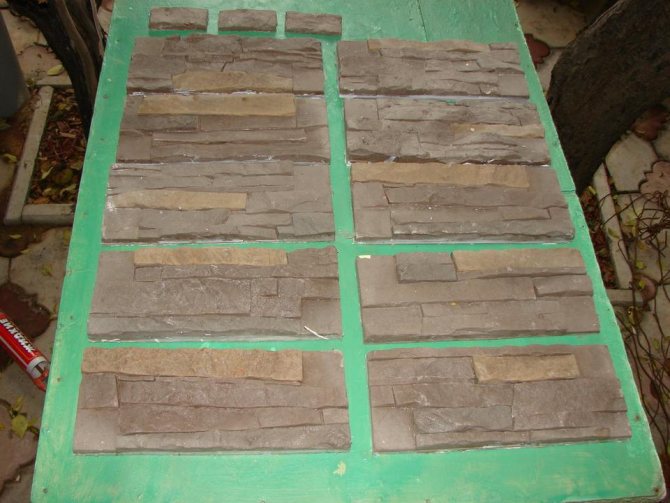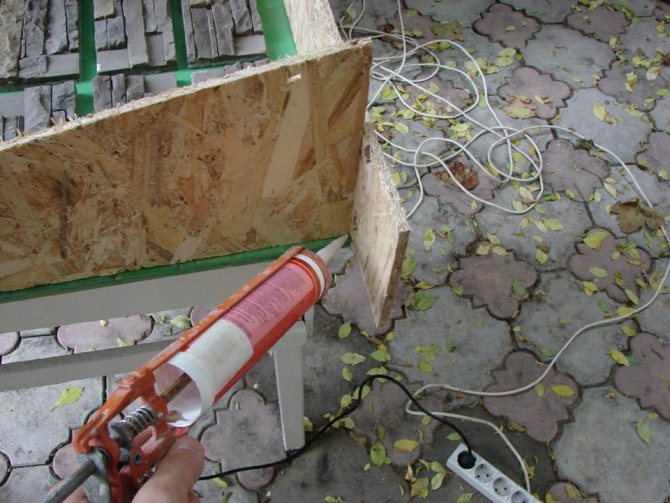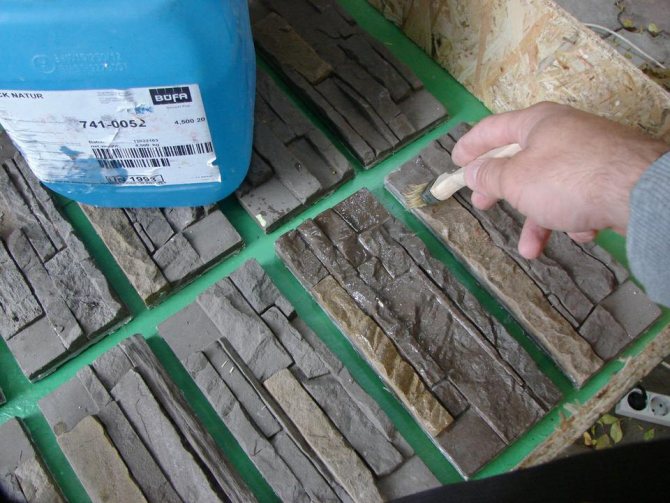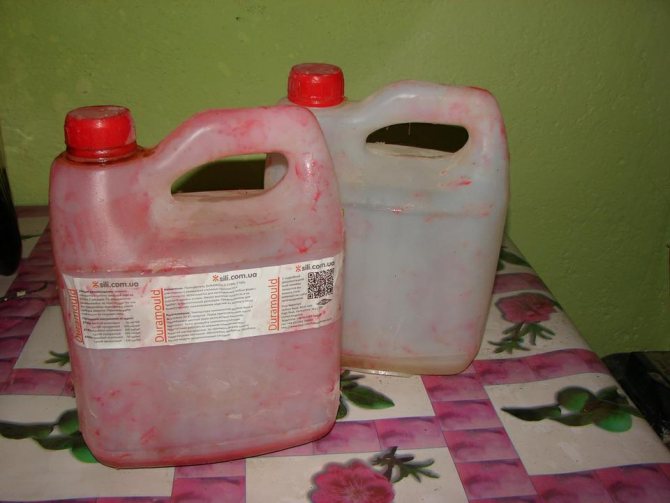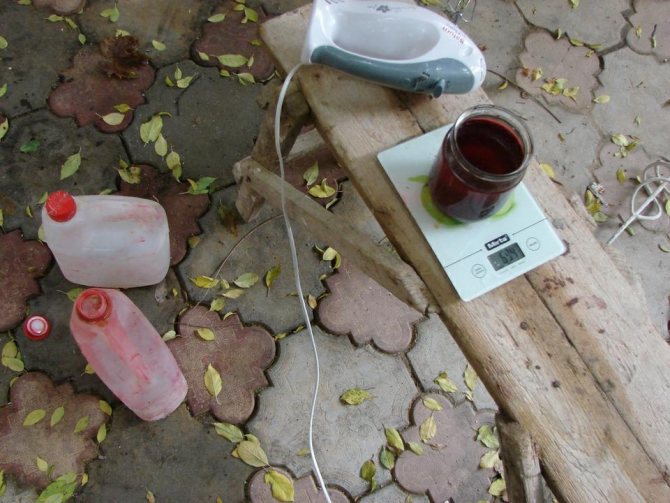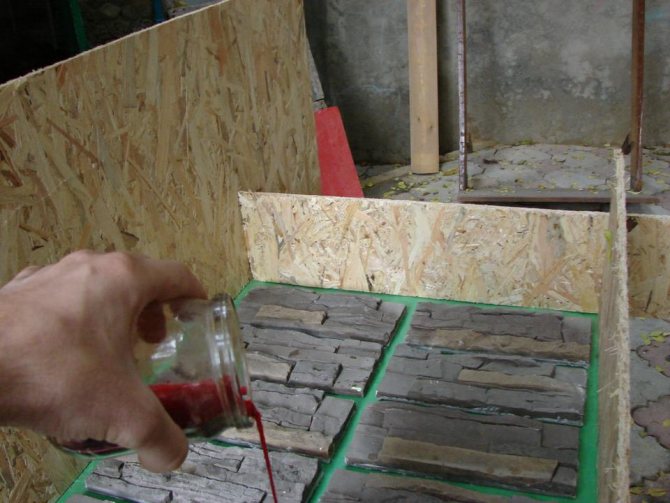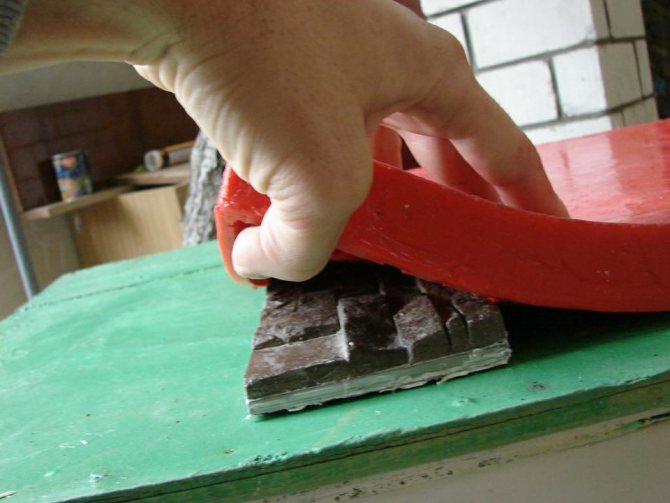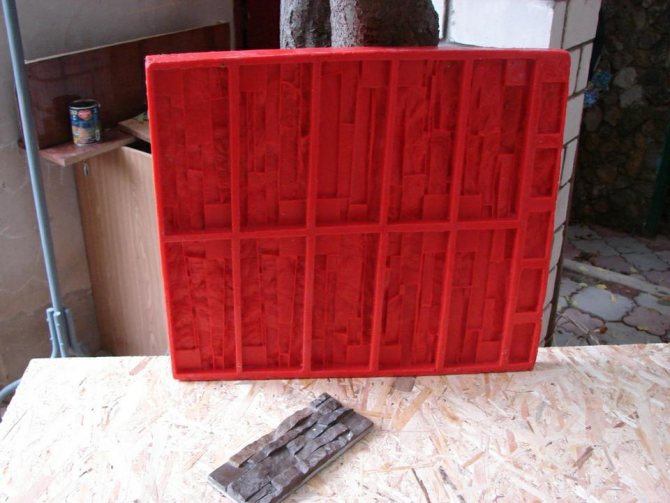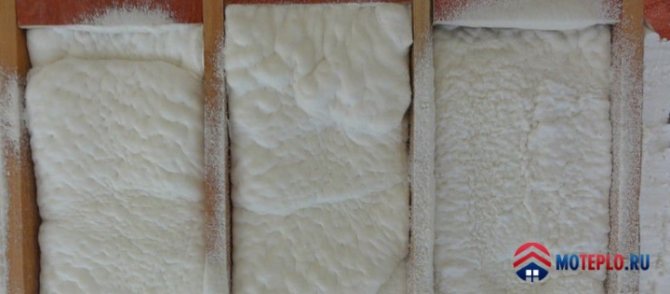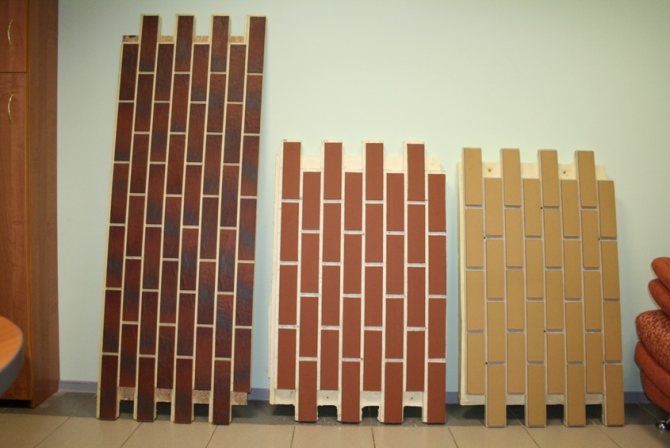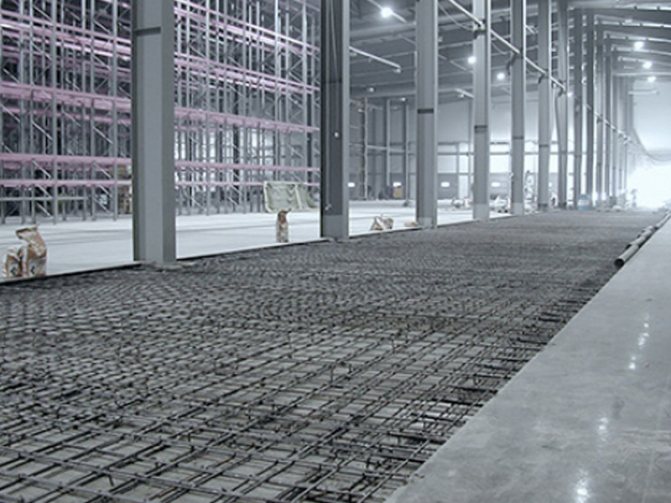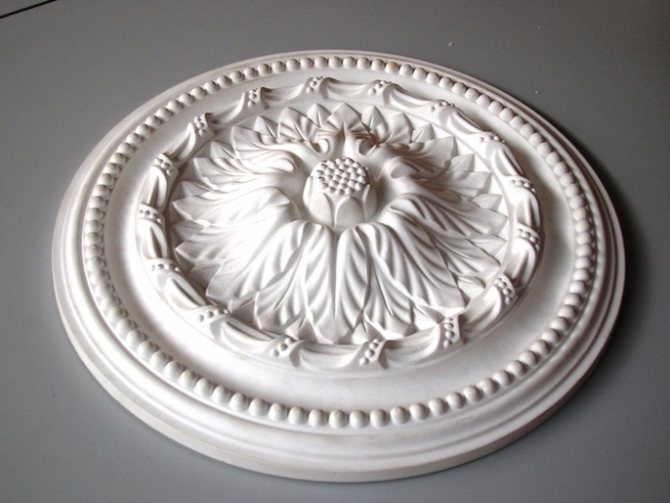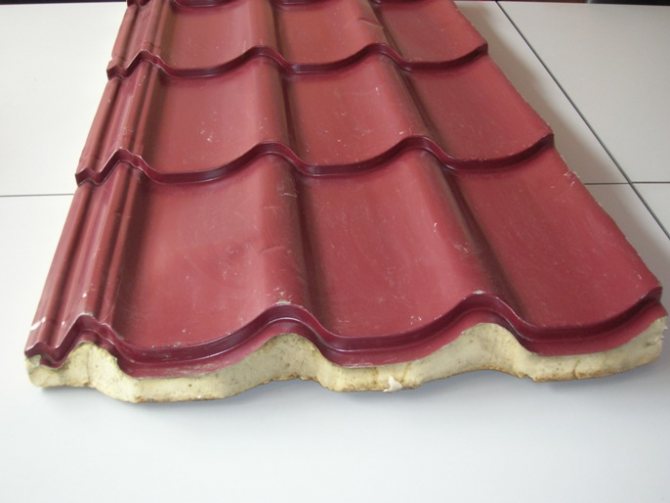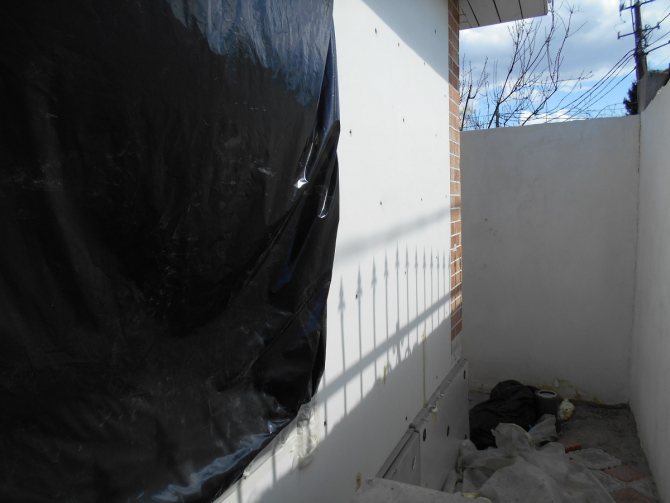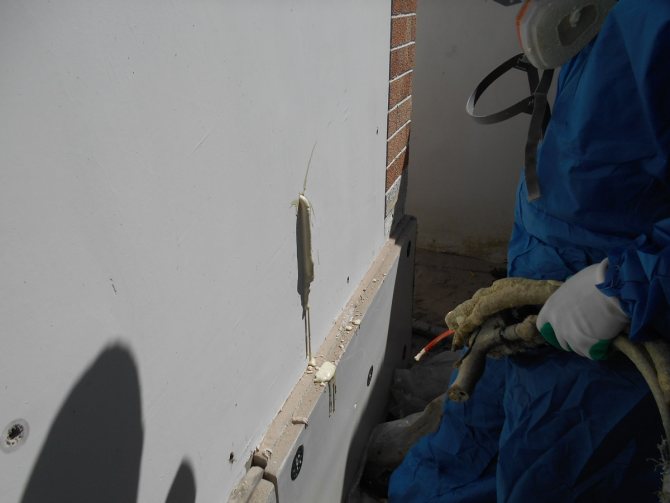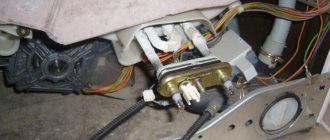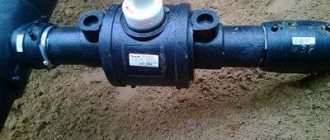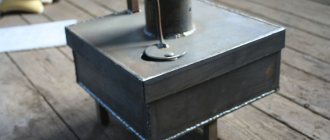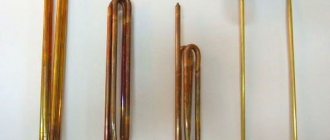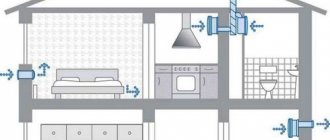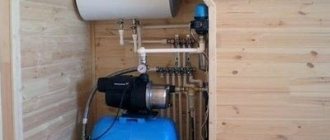Wall insulation with PPU filling
Pouring polyurethane foam into inter-wall voids is used to insulate and strengthen the walls of a house under construction or an already in use structure. When building houses, brickwork of 1.5 or 2 bricks is used. According to SNiP II-3-79, in order to provide adequate protection from the cold, the wall thickness must be at least 1.2 meters.
It is impractical to use such a number of bricks due to the load on the foundation and the complexity of installation, therefore the walls are made two-layer. Internal and external are erected, leaving a space of 50 centimeters between them for free air circulation. This helps to retain heat and prevent condensation from forming. But this is not enough for full-fledged insulation. It is difficult to insulate the space between the walls with rolled or soft materials. The method of filling the voids with PU foam allows you to evenly fill all the gaps inside the walls and between them.
Technology of filling the pipe with polyurethane foam from above
When pouring from above, the pre-assembled pipes are also positioned at an angle of 1 ° to 15 ° to the horizontal (see Fig. 2.). However, in this case, the required amount of foam mixture is introduced into the area between the steel pipe and the HDPE pipe through an opening in the top cap. The force of gravity causes a mass of relatively low viscosity to flow down the pipe. The speed of this flow depends on the angle at which the pipes are located, the larger it is, the faster the mass flows down. This method also assumes an initial distribution of foam along the pipe, before the foam expands rapidly. The foam further fills the pipe from the center to the ends. Experience has shown that the best distribution of properties is obtained when the foam reaches the bottom vent approximately twenty seconds earlier than the top. Naturally, immediately after this, the ventilation holes are sealed.

Fig. 2
The initial distribution of the material reduces the distance that the expanding foam has to travel until the space between the pipes is completely filled. This allows for reduced overflow or minimum fill volume. This makes it easier to fill longer pipes. High foam uniformity and narrow foam density distribution is achieved when the correct pipe angle is selected. However, in this case, this angle is more important than when pouring from below, so the operator's skill must be higher. It is highly recommended to use tables that provide the appropriate fill angle data.
Features of using polyurethane foam for pouring
After mixing components A and B, the polyurethane foam for pouring is a plastic mixture. After hardening, it becomes dense and tough, has a cellular structure. The material is lightweight and hard, does not deform or break.
The thermal conductivity coefficient of polyurethane foam is one of the lowest - 0.022 W / mK. Therefore, even a small layer of a few centimeters is enough to protect the structure from the cold. PPU has high adhesion, is attached to metal, glass, wood, concrete. Penetrates into pores and cracks, fills them and maintains a homogeneous structure for 30 years.
How to make a mold from liquid polyurethane. Step-by-step instruction
Hello everyone! We regularly post thematic guides on the storage and operation of polymer products on our website, as well as talk about the innovations in this area and its innovations.Earlier we told you about how to prepare our polyurethane for use, as well as laid out general educational information about elastomers such as polyurethane for molds and their derivatives. Our guides include information on adhesion, degassing of polyurethanes and injection moldings, as well as footnotes on Shore A hardness and more. In this article, we would like to present to your attention a step-by-step guide on how to cast our polyurethane for Advaform 40 molds to make a mold for a decorative stone. We also note that this instruction is applicable not only to our polyurethane, but also to other cold molded elastomers (but in compliance with the relevant instructions).
Step one. Collecting the necessary tools. A list of all the things that we need to produce a polyurethane mold: Liquid polyurethane for Advaform 40 molds, formwork (or boards or other items from which it is assembled), release agent or lubricant, master model (a sample of the stone that we are going to copy in the mold), a container in which we will mix polyurethane and a drill with a nozzle - a mixer (ideally), and so - an ordinary cane or board will do.
Step two. Formwork preparation. We assemble our formwork from boards or other materials that are suitable for this purpose. When assembling the formwork, observe the main rules: It must fit snugly to the surface on which it stands, and the edges of the formwork themselves must form tight joints. All cracks must be tightly closed.
Step three. Preparing the surface. Model master - lay out the samples inside the formwork. The surface and all the faces of the formwork with which the polyurethane will interact is treated with a release agent. It is important to observe the golden mean: do not use too much composition, but apply it in such an amount that the future shape does not stick when removed. Typically, this is 2-3 brush strokes.
Step four. We prepare and mix the polyurethane components. How to prepare liquid polyurethane for casting was described in our previous article. The components themselves, after preparation, should be mixed in a separate container, successively pouring them there. Stir the polyurethane slowly, at low speeds until a homogeneous liquid is formed.
Step five. Filling the form. After all the previous steps have been completed, we proceed to pouring our mixture. It must be poured slowly and at one point. The casting itself should continue until the master model is hidden under a layer of polyurethane by 1.5-3 centimeters.
Casting equipment
For pouring the walls of PPU, pouring complexes are used. Such equipment allows you to accurately dose the components to obtain polyurethane foam, mix them to a homogeneous state, and pour them into the space between the walls. Installations are of high pressure (over 100 atmospheres) and low pressure (4-10 atmospheres).
In high-pressure devices, mixing of the components occurs due to penetration into each other. In low pressure washers, materials are mixed with a special mixer. Air does not participate in this process, because its bubbles lead to the formation of voids inside matter. PPU is brought to the surface using a spray gun.
Low pressure installations usually weigh up to 100 kilograms. This makes it easy to move them in space when pouring PPU walls. They are easy to use and can be used at home. The disadvantages include the short length of the spray nozzle hoses, the higher material consumption compared to high pressure installations.
The performance of high-pressure installations allows filling large areas, using hoses up to 120 meters, avoiding the formation of suspended matter near the spraying site.The disadvantages include the high cost of equipment, weight over 100 kg, complexity of use - a specialist is required to work with the installation.
Optional equipment
Carousel conveyor for 4-8 forms (for shells)
Casting molds for various types of polyurethane foam products
Molds with a segment angle of 180 degrees. (half cylinder) for casting polyurethane foam shells
Flat mold for casting PPU-plate 1200x600x50
Mold and finished product (pillow) from elastic molded polyurethane foam for furniture
Mold and finished products (headboard) - furniture items
Mold and finished product (ceiling rosette) - decor element
Custom-made molds for molding flexible polyurethane foam armrests for medical chairs
Punch (upper half of the mold, with a sprue for injection) of the product "Office chair seat"
Mold for casting from polyurethane foam products of the "grater" type
Mold for casting a "box" of polyurethane foam (winter angler's chest, stand cooler for a beer dispensing unit)
Mold for pouring metal doors, designed for simultaneous stacking of up to 8 doors.
A mold for the manufacture of thermal panels faced with clinker tiles and finished products obtained in this form.
Examples of high pressure installations:
- Polymer complex PK-60 - capacity up to 60 l / min, self-cleaning filling head, asynchronous gear motor, industrial controller with touch display;
- Graco HGR - capacity up to 20 kg / min, hydraulic drive, prime controller, automatic ratio accuracy. Watch the video how the Graco installation works using the example of the inter-wall pouring "Chemtrast SKZ-20":
- Hennecke - capacity up to 35 kg / min, hydraulic drive, built-in containers of 250 liters, filling head, automatic control of dosing accuracy.
The technology of pouring a pipe with polyurethane foam with a broach
The pulling method is similar to the moving head pouring technique in that it is a batch pouring method with continuous foam injection. The pipes are held horizontally. The foam is applied to a thin, semi-permeable paper membrane located between the primary and secondary pipes. As the foam is applied, the membrane is pulled along the pipe (see fig. 5). The foam begins to expand inside the pipe as it moves towards the far end. The foam needs to travel a short path, which allows it to work with minimal overflow. In this way, the same foam properties can be obtained along the pipe. The constant distribution of the mixture of components in the pipe makes it easy to fill long and narrow pipes up to 30 meters long. The disadvantage of this casting method is that the membrane remains inside the foam, which can lead to poor adhesion of the foam to the outer pipe. It is also necessary to coordinate the volume of components poured onto the membrane and its permeability.
Fig. five
Polyurethane foam filling technology
There are two approaches for thermal insulation of hollow walls using the PUF casting method. If the building is under construction, the material is poured from above between the outer and inner walls. To do this, choose polyurethane foam with a high start time - 30–45 seconds. For example, "Khimtrust SKZ-30 (slowed down)". The substance has time to go down, and then begins to expand, filling all voids and cracks.
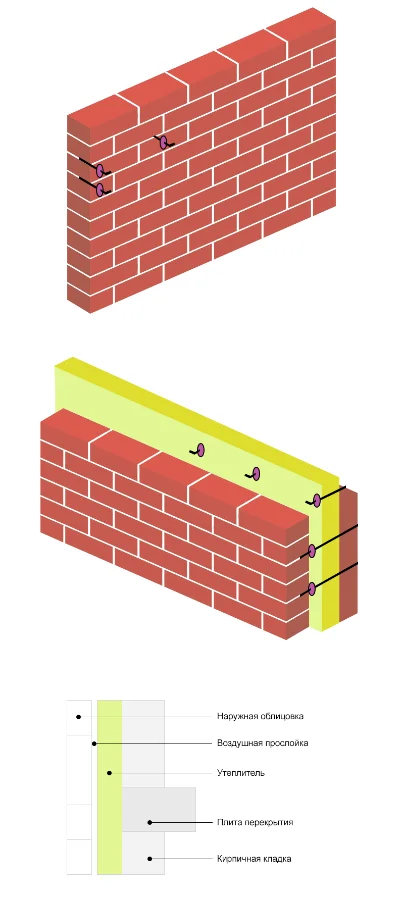

How to fill polyurethane foam if the building is already in operation? To insulate the built house, the PPU pouring between the wall and the cladding is carried out outside. Usually, a material with a low start time is used - 10–20 seconds. For example, "Himtrust SKZ-20". In the outer wall of the house, holes with a diameter of 12-14 millimeters are drilled at the depth of the brickwork. The distance between the holes is 50–100 centimeters. They are placed in a checkerboard pattern. It is necessary to fill the holes of the PU foam from the bottom up.This will distribute the material evenly, without voids inside. After filling, the holes must be closed with wooden dowels so that the material does not leak out. Polyurethane foam hardens in 1-2 minutes, forms a dense moisture-proof layer between the inner wall and the building cladding.
Types of filling polyurethane foam
The PPU filling plant is a mechanized complex, inside of which two liquid components are qualitatively mixed. They are polyol and isocyanate. According to the documentation adopted in the Russian Federation, polyol is labeled as component A, isocyanate - as component B. The dosed volume of these liquids is fed into the mixing chamber.
IMPORTANT! The components are thoroughly mixed in the chamber. This function is performed by a dynamic mixer without compressed air. The composition obtained as a result of mixing is fed into a mold specially prepared for this operation. This process is called polyurethane foam filling.
For filling, there are a number of manufacturers of excellent domestic installations. The most popular products on the polyurethane foam market in Russia are aggregates, Moscow. The company is a leader in the industry and offers its partners various types of polyurethane foam filling machines:
PK-60 - 60 liters per minute;
PK-90 - 90 liters per minute;
PK-200 - 200 liters per minute.
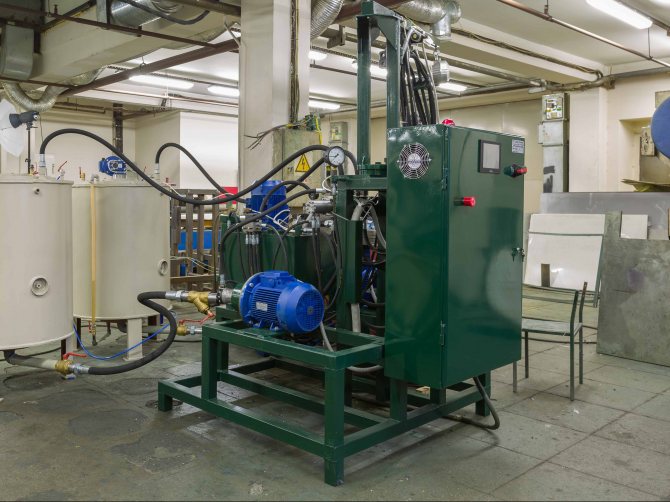

Each unit slightly differs from the others in its design, mainly in performance. The basis of all complexes:
- pouring unit;
- the capacity is hydropneumatic;
- pumping dosage device.
The rest of the units and mechanisms refer to additional options that serve to automate, simplify, and control the quality of the pouring process. Depending on the type of foam used, performance, each filling polyurethane foam is equipped with them. You can buy such equipment on the Internet portal and through the sales department of the enterprise.
Pouring equipment made abroad has become widespread in Russia. Domestic manufacturers massively use polyurethane foam filling systems in Moscow and all regions of the Russian Federation from the following global brands: Graco (USA) and Garaf (Spain). In recent years, Graco has been developing particularly rapidly together with its GlasCraft partner, the Spanish company Gusmer.
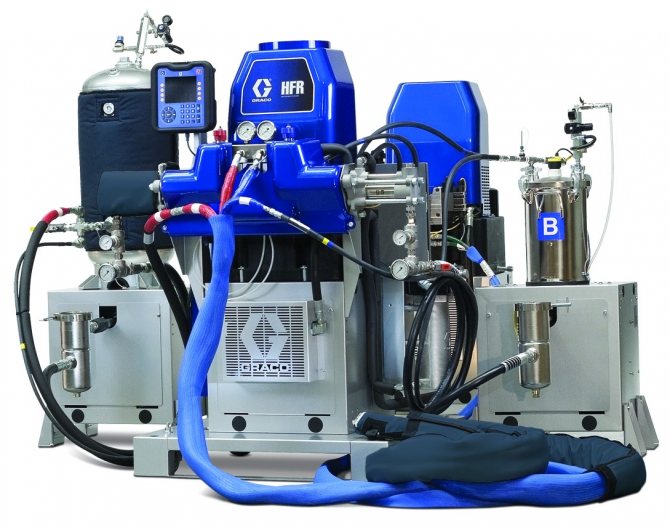

In parallel with the products from the USA, well-known global brands for pouring polyurethane foam from Germany, Italy, and China are used in Russia. The price of a casting plant for polyurethane foam in Moscow, depending on capacity and productivity, varies between 100,000 and 500,000 rubles. In Russian regions, you can buy a polyurethane foam filling system for 50,000 - 300,000 rubles.
Differences in machine performance
Each filling machine has its own production volumes and individual power characteristics. It is not difficult to buy equipment for pouring polyurethane foam, however, before buying, you need to clearly analyze your own needs for this technique. The unified classifier of PPU filling equipment provides for the production of two groups of machines:
- Small, with a filling capacity of up to 12 liters per minute.
- Large, with a filling capacity of up to 48 liters per minute.
NOTE!
Small units are equipped with 3G electric motors with a power of 0.75 kW, voltage of 220 V. The rotor rotates under load inside the mixing chamber with a frequency of 3000 - 4200 rpm. The volume of the mixing chamber is 200 cm³. Manufacturer's warranty: one year from the date of entering into a permanent operating mode, but not later than 90 days from the date of sale.
Large units are equipped with 3G electric motors with a power of 0.75 kW and 1.1 kW, with a voltage of 380 V. The rotor rotates under load inside the mixing chamber with a frequency of 3900 - 4500 rpm. The volume of the mixing chamber is 280 and 340 cm³.Manufacturer's warranty: one year from the date of entering into a permanent operating mode, but not later than 90 days from the date of sale.
Difference in linear and stand-alone operation
In low-pressure installations, the components are mixed in a mixing chamber with a working pressure of 6-10 atm. When pouring, the entire mass is mixed with a mixer. The latest models produced by Polymer-Complex are equipped with polyol and isocyanate heating units.
The high-pressure polyurethane foam system mixes the components in the mixing chamber at an operating pressure of 140 atm. With this technology, the components are mixed, penetrating into each other. The price of a high pressure unit on the polyurethane foam market reaches 300,000 rubles. The polyurethane foam filling system in Moscow assumes the parallel operation of both low and high pressure units.
ADDITIONAL INFORMATION
The autonomous operation of the PPU filling machine consists in the complete independent functionality of the unit. Mixing of liquid substances is carried out in a closed chamber. Further, the mixture is fed through a fishing rod with slot-like nozzles into a castable mold. The polymerization of the resulting emulsion is achieved instantly through a spray torch on the surface of the base.
The installation is completed with special pistols for precise hitting of the PPU jet into the mold. The productivity is 6-20 liters per minute. This is how an autonomous filling machine works. The installation price is 50-100 thousand rubles. Linear pouring machines are not much different from their stand-alone counterparts. They successfully work on trunk pipelines and bridge construction.
Their forms for filling are much more voluminous. Linear units have a capacity of 10 to 500 liters per minute. The cost of such units is 300,000 - 500,000 rubles or more.
Advantages of filling walls with polyurethane foam
The method of pouring polyurethane foam between the walls allows you to insulate the building at any stage of construction, as well as during operation, without disturbing the interior decoration of the premises. Polyurethane foam has no shrinkage, so there is no need to worry about the integrity of the thermal insulation layer. Waterproofness avoids the formation of bridges of cold, condensation, mold. Components for filling polyurethane foam have a thermal conductivity coefficient of 0.023 W / K to 0.03 W / K. "Khimtrast SKZ-30" is suitable not only for heat, but also for sound insulation of inter-wall spaces.
Watch the video about the features of filling the polyurethane foam with the Khimtrast SKZ-30 system of components.
Chemtrast products are available in 14 warehouses throughout Russia. When ordering components in the online store from a ton, cumulative discounts apply. Delivery across the Russian Federation and the CIS.
Technology of filling pipes with polyurethane foam from below
When pouring from below, the pipes are positioned at an angle of 0 ° to 15 ° to the floor plane (see Fig. 1). The choice of angle depends on the length of the pipe and the fluidity of the system used. The required amount of mixture is injected into the space between the steel and plastic pipes through a hole in the bottom cover. This is where the foam begins to expand. The hole is closed with a stopper as soon as the foam reaches it, which causes the foam to expand upward along the pipe. The exhaust air is discharged through the vents in the top cover. Once the foam reaches the top vents, they are sealed as well. The system is left for some time to complete the reaction, after which the end caps are removed.
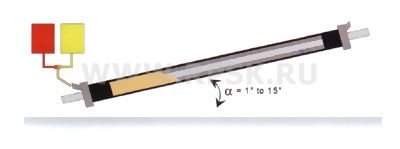

Fig. one
The main advantage of this method is its simplicity. The angle of inclination of the pipe is variable and does not require much skill on the part of the operator. The technology makes it possible to produce pipes of different sizes with minimal equipment changes. The main disadvantage is the uneven distribution of foam along the pipe, and hence the mechanical properties.The highest density of the foam will be at the bottom of the pipe, while the lowest will be at the top. Since the foam has to travel a long way in the narrow space between the pipes, a large overflow is required. It is also necessary to have a special table of the dependence of the angle on the length of the pipe.
Progress
PU foam is supplied to the site in the form of two liquid components, marked with the letters A (polyol) and B (isocyanate). Before proceeding to mixing these substances and pouring the mixture into the cavity, the polyol must be heated to 30-350C, and the isocyanate to 40-500C. Then component A is mixed for 10-15 minutes until smooth. We do all this in a special hydraulic unit with a built-in heating system and heated hoses. With the help of a pistol, the polyurethane foam composition is fed into the gap of the wall, where it expands and fills the empty space between the limiting surfaces, as well as the smallest cracks, defects in masonry or slabs.
To order the PUF filling service, call by phone in Moscow or send a message through the website. We will quickly insulate your object, and you will forget about heat leaks for several decades.
Technology advantages
The advantage of foam is that it gets into the most difficult to reach areas, sealing and strengthening your building. Excellent protection against street noise. The insulation is safe for humans and animals, has a low flammability class, does not emit dust and odors, and does not cause allergies. The material does not absorb moisture, does not form fungi and mold during operation. A small layer is sufficient, as this type of insulation has one of the lowest thermal conductivity coefficients on the market. As a result, you get a durable monolithic layer of effective thermal insulation that will not lose its properties over time and will keep your home warm. Correctly poured foam does not shrink, does not crack and will serve you for more than a dozen years.
